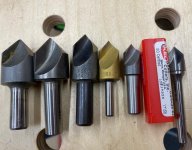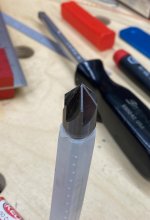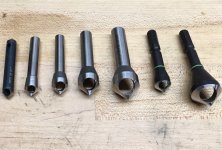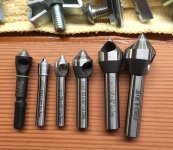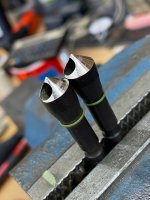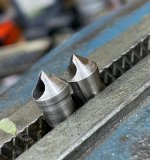Where to start...this can be a complicated subject. [big grin]
For mild steel I'd go with the traditional single flute Ford style countersink. Slow the speed down and use plenty of cutting oil. Make sure you take a bite, .001"-.002", don't try to just skim the surface because that can cause chatter and once it starts it's tough to get rid of it. You can peck a countersink much like pecking a deep hole. Go in, take a bite & get out...repeat until you've hit the right dimension.
When using a countersink the diameter is constantly increasing that's the reason the slower speed is critical. You run a 3/8" drill bit slower than a 1/4" drill bit. If you have any more than 2-3 of these to do, I'd definitely run them on the drill press. Once the first one is done to your satisfaction, be sure to set the quill stop to ensure they will all have the same diameter/depth. For this application I'd prefer using a vise to hold the metal strap and then securing the vise to the drill press table.
For steel here are my go-to countersinks. L to R: Severance, Ford, Ford, Ford with TiN coating, Severance & finally a KEO solid carbide 6 flute. All are 82º even though Severance uses 41º nomenclature. The 6 flute is also known as a chatter less, however that's not necessarily the case. [crying]
[attachimg=1]
[attachimg=2]
Another method I've been using lately for aluminum and I think this would also be viable in ferrous materials is a spotting drill. Here are some Hertel 82º carbide spotting drills.
https://www.mscdirect.com/product/details/59918953
Like others mentioned, I love the zero flute countersinks and they are my favorite for aluminum, plastics & wood, but
not for steel unless it's just a quick deburring issue. Even though the KEO are machined from cobalt, they will dull quickly when used on ferrous metal products and that's because of the thin wall on the cutting edge.
Here's a shot of the 82º zero flute countersinks I use: Norseman, KEO, KEO, KEO, KEO, Festool & Festool. The KEO are cobalt while the Festool are HSS. It's best to use the KEO in plastics and aluminum and save the Festools for wood. I've used the small Festool in aluminum before and after 3-4 holes the Festool was toast. Again if using the KEO in non-ferrous materials use a lubricant it helps a ton. I prefer to use IPA if there will not be any sparks generated. It evaporates quickly and is cleaner than anything else.
[attachimg=3]
[attachimg=4]

